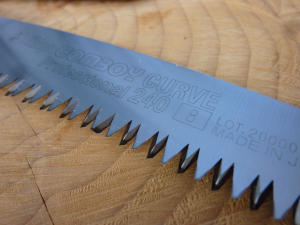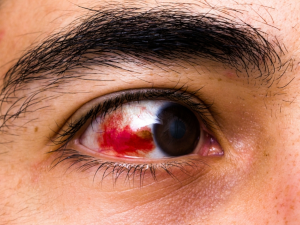Workday Safety
No matter if you're a shiny new volunteer, or seasoned veteran with 500 hours under their belt, safety should always be your top priority. In order to stay safe, you must be able to identify the threats in your environment, or know when a situation can turn dangerous. Only then can you take corrective action to prevent harm from befalling you or fellow volunteer. This is the basis of Hazard Awareness.
Corrective action can take several forms:
- you can eliminate the hazard
- replace it with something less dangerous
- put up a barrier between you and the hazard
- reduce the duration or frequency of your exposure to the hazard
- reduce your risk by wearing personal protective equipment.
Throughout this section, we will highlight the different threats you may encounter during the course of a workday. These can be the tools we use, the terrain and environment, the weather conditions, and the plants and insects we come into contact with.
General Hazards

Serrated Edges
Of all the hand-tools, those with serrated edges pose the biggest risk. Serrated edges are by their very nature sharp, and when they go head to head with bare skin, they usually come out on top. For this reason, you should always wear leather gloves when handling saws or hand sickles. When not in use, saws should be folded up or stored in a sheath, whichever is applicable.
To illustrate the dangers, I will share two incidents that happened to myself. This first occurred when cutting a branch above shoulder height, and on the pull stroke, the saw slipped. As I was holding the branch with my left hand, it tore through a new pair of leather gloves and resulted in a cut on my index finger, drawing blood. The second event occurred when kneeling down to cut the trunk of a buckthorn tree. Once again, on pulling the saw it proceeded to rip through two layers of fabric, leaving a one inch long gash above my left knee.
In both cases, I was careless applying too much force using the saw, which lead to my body being in the line of fire. While I was wearing PPE - gloves, cotton duck jeans - it was not enough to prevent injury.

Pokey Ends
Whenever you find yourself cutting the shrubbiest of shrubby shrubs, you need to be mindful of branches and twigs that can poke you in the face. I have had a few near misses using loppers to cut honeysuckle: reaching in to find a branch to cut, I turned my head only to have a close encounter with a rogue branch.
I have not always been so lucky. I have been poked in the eye by a branch when navigating through brush. It's not pleasant, and had I been wearing safety glasses, I would have been spared this delightful experience.
I will confess that I am bad when it comes to wearing safety glasses, at least when brush cutting. Part of the reason is I wear glasses everyday, so need a special pair that fits over them, which I keep forget to bring. The bigger reason is complacency.

 Volunteering
Volunteering Safety
Safety Wildlife
Wildlife Newsletter
Newsletter